How to pitch a story
Everything I’ve learned about the art of pitching as a freelance journalist
Two years ago, Jamal Jordon, a former reporter at the New York Times, tweeted that journalism school should include a course on how to freelance in the inevitable event of being laid off.
I’ve never forgotten that tweet. I thought of it this April when I was made redundant from my job at a newspaper. Suddenly I was thrown into the freelance life, where you’re pitching for your bread and butter, and I had no choice but to learn how to do it. And yes my journalism masters - which offered modules on investigations, shorthand, media law and interactive journalism - did not dedicate a single class to teaching us how to pitch. An omission I still find mind boggling.
Six months into freelance life, I’ve developed a taste for crafting a pitch. And it’s been essential. Almost all the work I’ve had published this year - I’d say a solid 85 per cent - has been the result of a pitch. But I remember those nerve-wracking first few weeks, alone in my flat in front of a blank screen, trying to turn an idea into a pitch. Here are the pointers, I wish I’d had back then, my own master class on how to pitch…
Writing that pitch
Once you’ve got a workable idea, the toughest part is over. Now you just have to put the pitch together in a way that does justice to your idea - i.e. sells it - and makes it super clear what you are offering. Editors are very busy people. (I used to yawn at this but I recently covered for a comment editor and felt like I was stretched to capacity just getting the daily pages done and couldn’t even begin to process the flurry of pitches arriving in my inbox hour-by-hour.) You want your pitch to spell out the story and what you are offering so an editor can take it in with one glance and go: yes or no.
This is where formula comes in. I’m sure everyone has their own formula. I seem to recall someone once saying pitching is like sex, we all do it differently. Anyhow, here is my formula.
I put the top line in bold and I outline the story in bullet points below. The top line is kind of a mix of the first line of a news story and a headline. It spells out exactly what the story is about and it sells it too.
In the bullet points, I sketch out the story, what it is exactly, who I will talk to, I might include a line on why the editor should commission the story - for instance, why I think this topic would resonate with their readership in particular.
It’s probably easiest to illustrate this all by showing you a few pitches that have landed.
So this one, all about my experience with the antidepressant sertraline, was my first ever pitch after being made redundo. Here is the pitch:
And it became, through a couple of drafts, lots of pointers, and a shoot with a fastidious hair and make up artist, this story.
This pitch was about someone who had chosen to platonically co-parent (as in, meet a woman online, have a baby with her through artificial insemination so they never had sex, and raise the baby together as though they are divorced parents sharing custody even though they never had a relationship - I mean, my God, fascinating!).
That pitch turned into this story (after a lot of ads and a shoot where poor Nick had to pose with a baby model).
And then one more for luck, this pitch was about how people are giving up vaping at Allen Carr seminars.
And that turned into this story.
I think the key to pitching is to get that top line as good as you can get it - as shiny, as irresistible, as oh-my-god-I-have-got-to-run-this-story as you can make it. Then keep the rest of the pitch tight and easy-to-follow. Also, don’t overthink pitches. Really. The truth is, it’s the quality of the idea that is going to make or break it. You are just trying to present the idea as best as you can with your pitch.
Who do you send the pitch to?
I find it very irritating how everyone goes on about the need for ‘contacts’ when it comes to going freelance. I’d have thought that I needed to be close pals with half a dozen commissioning editors before I could give it a go if I listened to that guff. It’s not true. And repeating this nonsense makes the world of journalism feel even more exclusive and closed-off.
I’m not denying that freelancers who have worked with an editor in the past definitely have a leg-up when it comes to getting commissioned, but I’d argue that journalism, despite being invaded by nepo-babies as every industry has been, is actually quite meritocratic.1 It gives you the opportunity to show how good you are because it’s all about ideas. Ideas are what power newspapers and magazines, ideas are the petrol in the tank and any editor worth his or her salt wants a stream of good ideas coming in. And a good idea is a good idea whether it’s coming from an industry veteran, a newbie freelancer or the work experience kid.
So who do you send the pitch to? A human being. Do not be fooled by those generic email addresses. You need a point of contact - that’s someone with a job title and an email address at the paper or magazine. And here’s my advice - go to the top. Go to the person who can make the decision. Do not bother with a mid-runger who doesn’t have the authority to say yes or no. You want to go to the top dog, the head honcho, and this person - if they are any good at their job - will be delighted to get a good idea ping into their inbox.
In practical terms, it’s easy to find email addresses. Do some hunting on Twitter and LinkedIn. Work out the formula of email addresses at the publication (hint: it’s usually first name.last name).
I had never met, emailed or otherwise conversed with any of the editors who have commissioned my work. (Except for one but he only just commissioned me for the first time this week). The trick is to send a nice email of introduction along with your pitch. Keep this email succinct, polite and professional. This email isn’t the place to show off your writing style or demonstrate linguistic flair - this email is to show you are sane and that you will file usable copy to deadline. It’s also a good idea to include some examples of your work and I find the most seamless way to do this is to include a link to the page on your website where you have some previously published pieces (I really recommend getting a website if you are going freelance - I built mine on SquareSpace, it was easy and I think looks pretty profesh).
Send the pitch and leave the house
Urgh I hate this part and my advice, though I do not always follow it myself, is SEND THE PITCH AND THEN DO SOMETHING ELSE. Pull on a big coat and go for a stomp in the park. Or put on some music and dance about the room. Get stuck in to some other work you’ve been putting off. For the love of God, go and clean the bathroom but whatever you do - do not keep refreshing your emails waiting for a response. Do not keep checking them each minute that passes until you are seething with rage because you’ve not had a fulsome acceptance and big, juicy commission after ten minutes or worse, you’ve lapsed into despair and decided you will never work again.
Send it off and forget about it. You’ve done your work. It’s now in the hands of the universe (via an overworked editor).
The follow-up
So hopefully you’ve had your yes, confirmation of fee (always, always get this), and you don’t need to follow up. But sometimes you do need to follow up. The truth is, in my experience, when an editor is super keen on a story they will respond to your pitch without a nudge. But I have also followed up and got the green light. So I don’t believe the follow-up email is the harbinger of doom that I used to think it was.
I read somewhere to wait a week before following up and to that, I say: no, darling, we’ve got stories to place and money to make. I wouldn’t follow up on the same day (unless the story is time sensitive) but I think it’s perfectly fine to ping over a polite follow-up after a day or two.
Then fingers crossed, you get the commission (yay) or if not, it’s time to pitch it elsewhere. And repeat the whole process again.
My mix of feelings towards pitching
I have a love-hate relationship with pitching. It’s hard to emphasise just how demoralising it is to get enthused by an idea, spend time and energy crafting it into a pitch to the very best of your ability, send it off full of hope and then… crickets. It feels dispiriting and also vaguely undignified (though I know it shouldn’t). It helps to remember that other people have experienced the same thing.
, one of my favourite writers on Substack and the former editor of Elle and Cosmopolitan, movingly described the hurt of having your pitches ignored., who documents the freelance struggle brilliantly, has also tackled the frustration of pitching into the void.‘I lost count of the number of pitches I sent to features editors who simply ignored me… I remember sitting on a bench in Crystal Palace Park in a pair of UGG boots and weeping after yet another day of ignored features pitches. I felt so worthless, so without purpose, so irrelevant to anyone’s life, that I seriously considered leaving journalism.’
‘The time I spend on what I call ‘traditional journalism’ (reporting and writing features for mags and rags) has been an exercise in screaming into the void. My pitches go unanswered. Not because I don’t know how to pitch or who to send them to, but because the pitching system is broken.’
I agree, I think the system is broken and I’m not sure this way of life is sustainable. But I also can’t deny that the last six months of being forced to pitch the stories I want to write has also resulted in doing the work I’ve been most proud of.
Pitching offers you freedom. I was told this early on in my career by my news editor at a local paper. He called me into his office and said: ‘You must find your own ideas and go after the stories you want to do, otherwise you will simply find yourself doing what the news desk tells you to do and it will be boring.’
I wish I had heeded his words back then. Instead, just as he warned, I spent seven years being bossed around by various news desks. Now that I’m finally pitching on the regular, I can report that he was correct: it’s so much less boring. A story just hits different when it was your idea.
Thank you for reading all the way to the bottom! It means the world to me that you have checked out Things We Don’t Talk About (But I Do). If you hit the ‘heart’ button below it will help me get more visibility on Substack and if you have any thoughts, please tell me in the comments. Thanks as ever for reading xxx
Journalism is increasingly becoming an industry populated by the wealthy for many reasons - the instability of the work, the pressure to undertake unpaid work at the beginning of your career, the often paltry rates. I do still think it’s a place where great ideas can shine but I don’t want to discount how hard it is to make a decent living and how that has affected the kinds of people who go into journalism.




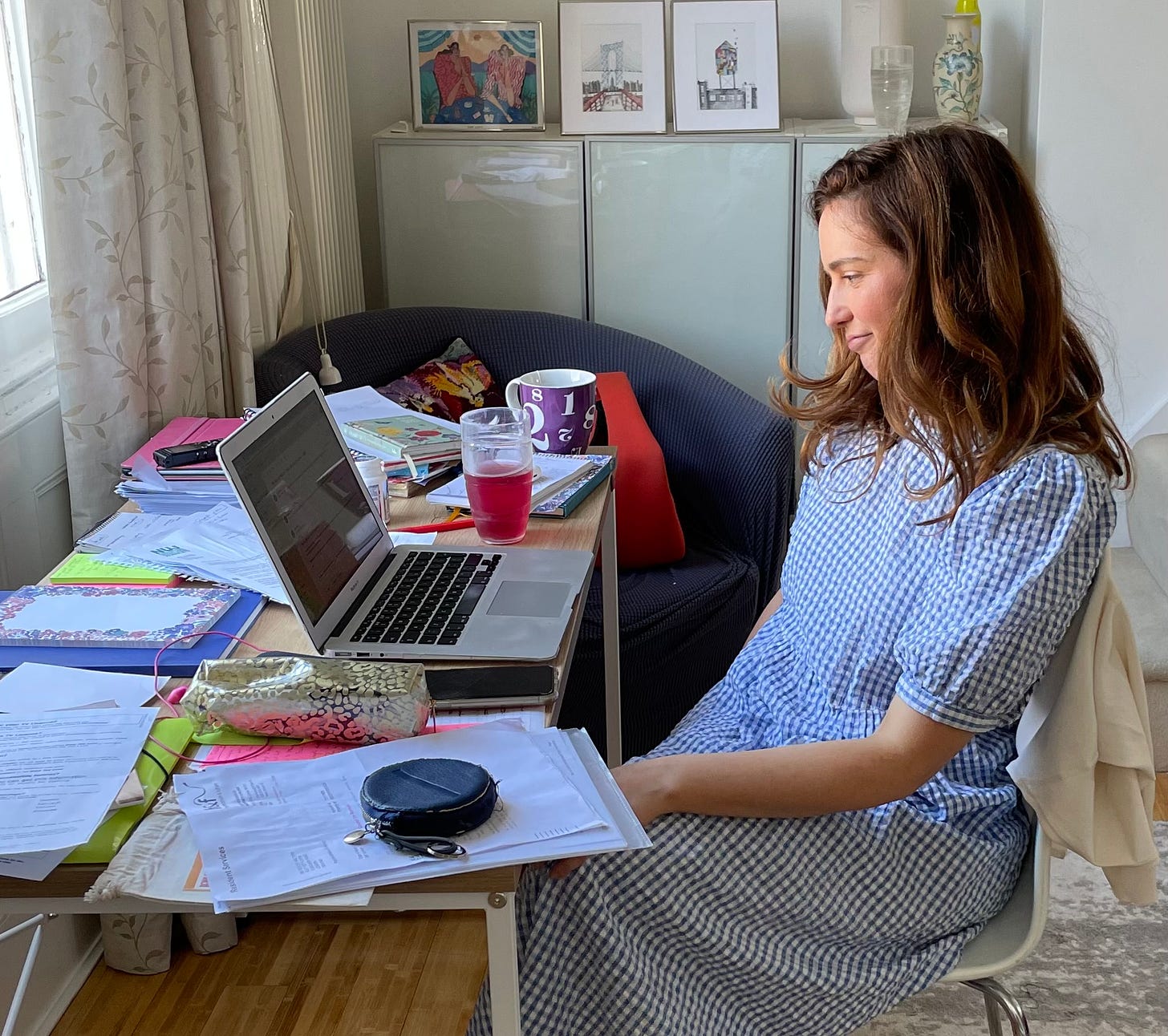
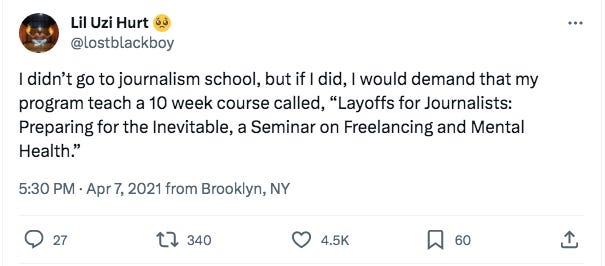
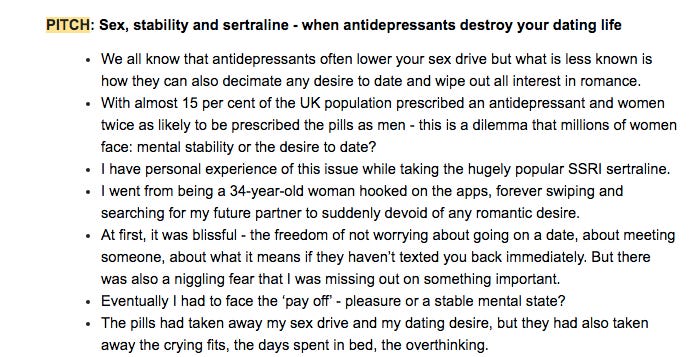


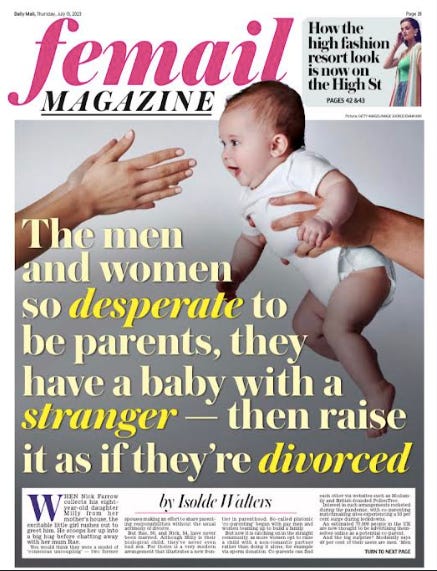
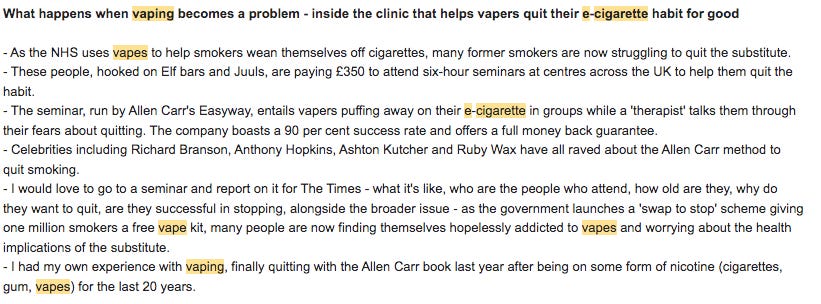


Isolde, I always know I'm going to enjoy your stories when I see your by-line at the top, and now it makes even more sense why. Thanks for this generous guide – invaluable for freelancers + staffers who freelance on the side!
A very insightful window into life as a freelance journalist! Amazing!